Rebecca R. Benefiel (Washington and Lee University)
Despite its destruction by the eruption of Mt. Vesuvius in the year 79 AD, the ancient Roman city of Pompeii nonetheless remains exceptional for its unique preservation of art, architecture, small and large finds - and graffiti! Indeed, without Pompeii, we might have no idea that the ancient world was filled with so much writing. Numerous posters advertising candidates running in local government elections were painted on the walls of the city. Thousands of messages were written by the city’s inhabitants, visitors, and members of the general population, scrawled and scratched onto the wall-plaster that covers houses and buildings. As these inscriptions continued to surface during the ever-expanding excavations of the mid-nineteenth century, they were described as “scratched inscriptions” (iscrizioni graffite). The adjective eventually came to be used as a noun and the term graffiti was born. Although the term expanded to be used for any writing on a wall in the 20th century, the word graffiti itself was originally a technical term for handwritten, scratched inscriptions found in the excavations of Roman ruins.
Ancient graffiti provide a fascinating window into the daily rhythms of life in the early Roman Empire. Their content is as unique and varied as the people who wrote them. They present quotations of poetry, greetings among friends, tally marks, grocery lists, personal prayers, moments of wit and humour, and more. Individually and collectively, these personal and personalised messages provide a perspective on Roman society - its economy, religion, spoken language, and activities within the ancient city. They humanise life in a city over two thousand years ago, repopulating the area with a flash of colour. Where else would we ever hear of Floronius, an apparently lusty soldier of the Seventh Legion, whose visit to Pompeii, as someone wrote, “went unremarked upon by few female inhabitants—six!”? Or, consider instead one acidic local reaction to the popularity of Vergil’s poetry, when one Pompeian wrote that he preferred the singing of “dry-cleaners and owls” to that of “arms and the man” (a caustic subversion of the opening line of the Aeneid). (For more examples of engaging ancient graffiti, see below.)
I began designing and building the Ancient Graffiti Project (AGP) in 2013 with a small team of classicists and computer scientists. Our goal was to create a digital resource for locating and studying ancient graffiti, with the aim of making these captivating inscriptions more accessible to scholars, students, and the general public. We have conducted fieldwork in Herculaneum and Pompeii since 2014 to document ancient graffiti as fully as possible. See Figure 7. Our team edits the handwritten inscriptions of the Vesuvian area (Pompeii, Herculaneum, and surrounding areas) for both AGP and our collaborative partner, the Epigraphic Database Roma, a database of inscriptions from the Italian peninsula from the 7th century BC to late antiquity. We have also built a suite of digital tools that specifically facilitate ancient graffiti research. With AGP, it is now possible to explore where ancient graffiti were written, how they appeared, and what types of hand-sketched drawings might appear nearby. We have edited and organized made more than 2000 inscriptions online. The sum of this data is freely available, and AGP is visited by ca. 18,000 users each year.
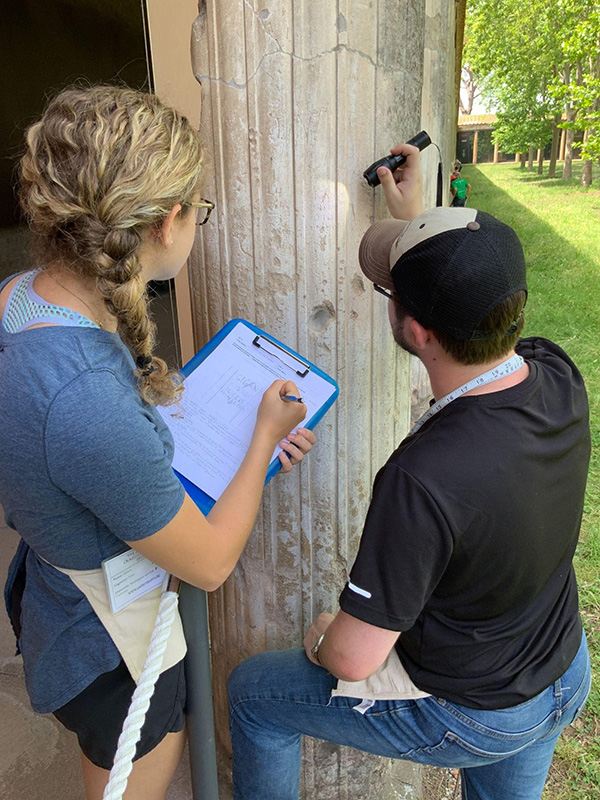
Figure 7: AGP team members Melissa Yorio and Henry Busby work to document an ancient graffito in the campus beside the amphitheatre at Pompeii. Ancient graffiti were lightly scratched into wall plaster and are often small. Today, they can be nearly invisible, and are easily overlooked.
Most importantly, we have built AGP to be a user-friendly resource which is oriented both for scholars as well as for non-experts. For each graffito, scholars will find a text displayed with standard epigraphic conventions, full bibliography and a critical apparatus, along with a full range of associated characteristics (or metadata). Since it is built from our fieldwork, we also provide illustrations of ancient graffiti whenever possible. Teachers can use the lesson plans, warm-up activities, and resources for incorporating ancient graffiti into the classroom as well. Those interested in reading or learning about ancient graffiti can explore on their own or use our ‘Featured Graffiti’ page for an introduction to the variety of handwritten messages from the ancient world.
We highlight here a few special features of the Ancient Graffiti Project, followed by a sample of some entertaining first-century ancient graffiti.
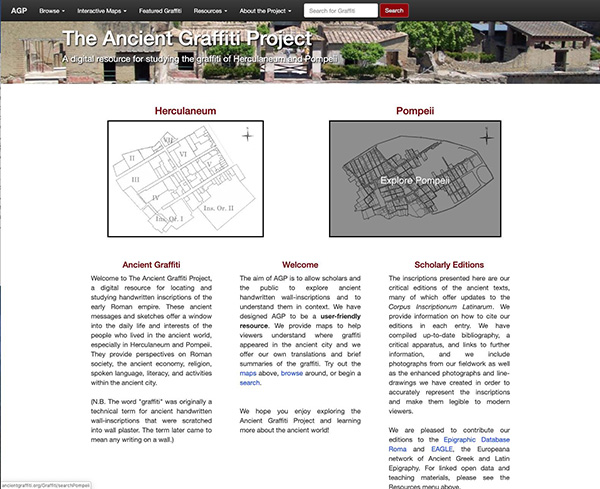
Figure 8: Homepage of The Ancient Graffiti Project
Special Features of the Ancient Graffiti Project
Maps: Because location and contextual information are essential for understanding a graffito, the primary search interface and homepage of AGP features interactive maps of the two major sites of Herculaneum and Pompeii. See Figure 8. It is possible to search for graffiti on building facades and inside buildings. When the user hovers over a building, the name and address of that building appear. For an expert, the property information tells them if they are looking at the appropriate location; a non-specialist will learn the name of the building and can easily scan through the main city. See Figure 9. Our team has checked the locations of graffiti against their full publication history, and we have furthermore correlated them to current maps of Pompeii and Herculaneum with standardised addresses for consistency.
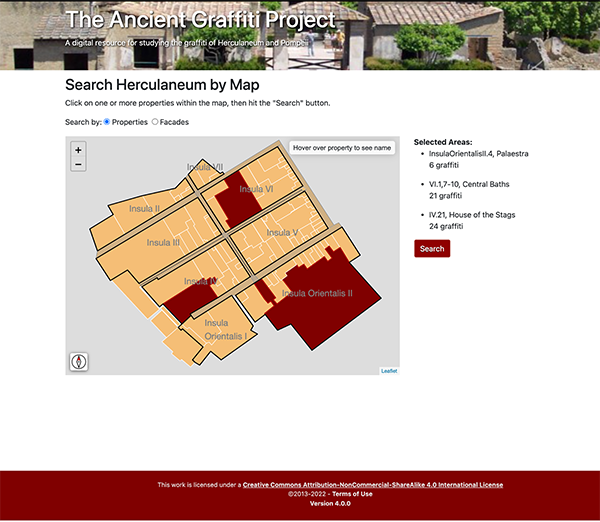
Figure 9: An interactive map allows students and scholars to search the entire site of Herculaneum to discover ancient handwritten messages.
Figural Graffiti: Figural graffiti represent a significant portion of ancient handwritten inscriptions. However, they were often omitted or reduced to brief verbal descriptions in earlier records. AGP offers an individual digital record for each graffito, including all graffiti drawings. We have chosen to fully document and illustrate these drawings in order to give users a holistic picture of all graffiti found in Herculaneum, Pompeii, and Smyrna.
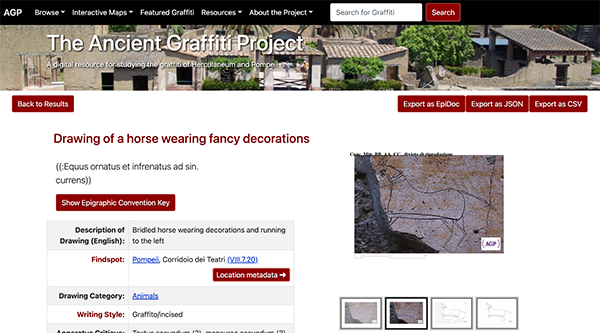
Figure 10: A figural graffito of a horse drawn at Pompeii. The image gallery includes photographs, enhanced photographs (large image, above) and line drawings.
Image Gallery: Each graffito is illustrated with a gallery of images that can include photographs, photographs with overlays, and line drawings. Clicking on an image enlarges it and makes it the central illustration. We create and display enhanced photographs and line drawings whenever possible, since ancient graffiti are extremely difficult to photograph and the thin ductus of the letters is hard to discern in photos. Toggling back and forth between the different images on AGP helps make the ancient inscription more visible. See Figure 10.
Filters: To help users better search the large corpus of ancient graffiti, we designed a set of filters to work in conjunction with browsing capability. These allow users to refine and/or restrict searches, or to create multi-faceted queries. Filter options appear on the left-hand side of any results page and include filters for city, property, property type, drawing category, writing style, and language. A user can select and combine any number of filters. See Figure 11.
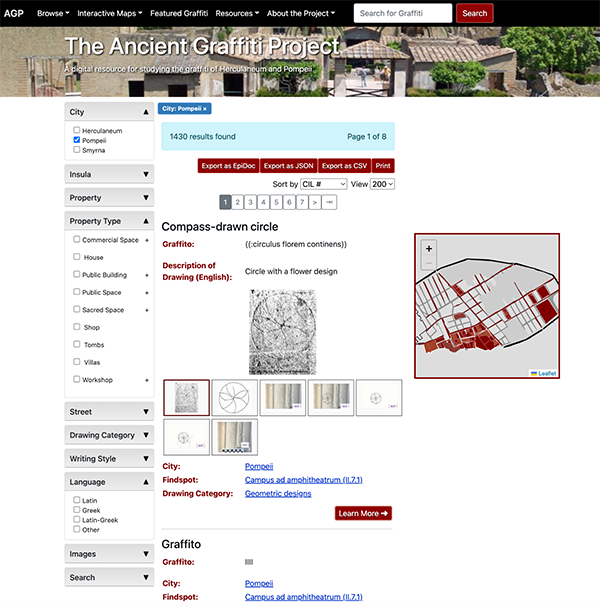
Figure 11: Filters (left) permit a user to create a customized search for graffiti.
Featured Graffiti: For those who want a taste of ancient graffiti, we have highlighted some of the most interesting graffiti from Pompeii and Herculaneum. This page allows users to explore graffiti thematically. Be it gladiators, love, food, or poetry, you can find examples so suit each topic here.
Integration with Other Projects: AGP is fully integrated within leading European epigraphic projects, such as the Epigraphic Database Roma and the EAGLE portal. Where relevant, AGP also provides links to the following online resources: Herculaneum Panoramas, Parco Archeologico di Ercolano, Parco Archeologico di Pompei, Pompeii in Pictures, and Pleiades.
A few examples of ancient graffiti:
- Augusto feliciter!
(“Long live the emperor!” OR “Cheers for the emperor!”)
Note: Augustus was the title for the emperor, not just the name for Rome’s first emperor. A literal translation of this popular cheer, which was used to wish friends and townsmen well too, is: “(May things go) happily for the emperor!”
- Vici Nuceriae in alia X DCCCLVS - fide bona!
(“I won 855 1/2 denarii in dice at Nuceria, without cheating!)
Note: A gambler wrote this note on a wall in Pompeii, the closest neighbor to Nuceria, a city a few miles away. This is a huge amount of money. The writer emphasizes the final phrase (without cheating!) by writing it in larger letters. Do we believe him?
- quisquis amat valeat. pereat qui nescit amare. bis tanto pereat quisquis amare vetat
(“Whoever loves, may she fare well. May he perish whoever knows not how to love. May he perish twice over whoever forbids love.”)
Note: This is a poem in the form of an elegiac couplet. It was written in several locations in Pompeii and seems to have been a popular refrain, even if we do not know the author of the sentiment. At least one Pompeian, however, altered the poem to rant at the goddess Venus. He finishes his version with the question, “if she can pierce my tender heart, why can’t I break her head with a club?”
- Birds are the type of animal most commonly drawn on the walls of Herculaneum and Pompeii, and then there is this sketch of a camel. See Figure 12.
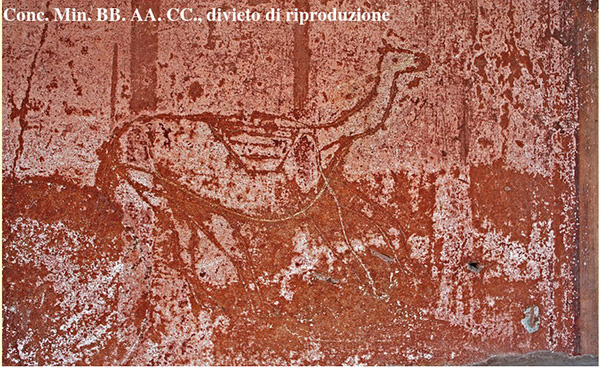
Figure 12: This camel was drawn inside a house at Herculaneum. It is thus far the only graffito of a camel known in the region of Campania.
Bibliography and further reading
-
Benefiel, R.R. 2010. Dialogues of Graffiti in the House of Maius Castricius at Pompeii. American Journal of Archaeology 114.1: 59–101.
- Benefiel, Rebecca R. 2010. Rome in Pompeii. Wall Inscriptions and GIS. In Latin on Stone. Epigraphic Research and Electronic Archives, edited by Francisca Feraudi-Gruénais, 45-75. Lanham, MD: Rowman & Littlefield.
- Benefiel, Rebecca R. 2018. Gladiators, Greetings, and Poetry: Graffiti in First Century Pompeii. In Scribbling through History. Graffiti, People, and Places from Antiquity to Modernity, edited by Elizabeth Frood Chloé Ragazzoli, Ömür Harmansah, Chiara Salvador, 101-116. London: Bloomsbury Academic Press.
- Benefiel, R.R. and Sypniewski, H.M. 2016. Images and Text on the Walls of Herculaneum: Designing the Ancient Graffiti Project. Off the Beaten Track. Epigraphy at the Borders, edited by A. E. Felle and A. Rocco, Archeopress (2016): 29-48.
- Benefiel, R.R., Sprenkle S., Sypniewski, H.M. and White, J. 2017. The Ancient Graffiti Project: Geo-Spatial Visualization and Search Tools for Ancient Handwritten Inscriptions. Proceedings of the 2nd International Conference on Digital Access to Textual Cultural Heritage (DATeCH2017): 163–168. DOI: https://doi.org/10.1145/3078081.3078104
- Benefiel, R.R. and Sypniewski, H.M. 2018. The Greek Graffiti of Herculaneum. American Journal of Archaeology 122.2: 209–44. https://doi.org/10.3764/aja.122.2.0209.
- Benefiel, R.R. and Sypniewski, H.M. 2020. Regio I - Latium et Campania. Fasciolo V. Pompeii - Tituli scariphati. Italia Epigrafica Digitale II, 1.2.5.
-
https://rosa.uniroma1.it/rosa03/italia_epigrafica_digitale/issue/view/IED%20II%2C%202.5
- DiBiasie Sammons, J. 2018. Application of Reflectance Transformation Imaging (RTI) to the study of ancient graffiti from Herculaneum, Italy. Journal of Archaeological Science: Reports. 17:184-194. DOI:10.1016/j.jasrep.2017.08.011
- Helms, K. 2021. Pompeii's Safaitic Graffiti. Journal of Roman Studies 111: 203-214. doi:10.1017/S0075435821000460
- Keegan, Peter. 2014. Graffiti in Antiquity. London and New York: Routledge.
- Langner, Martin. 2001. Antike Graffitizeichnungen: Motive, Gestaltung und Bedeutung, Palilia, 11. Wiesbaden: L. Reichert.
Go back to top